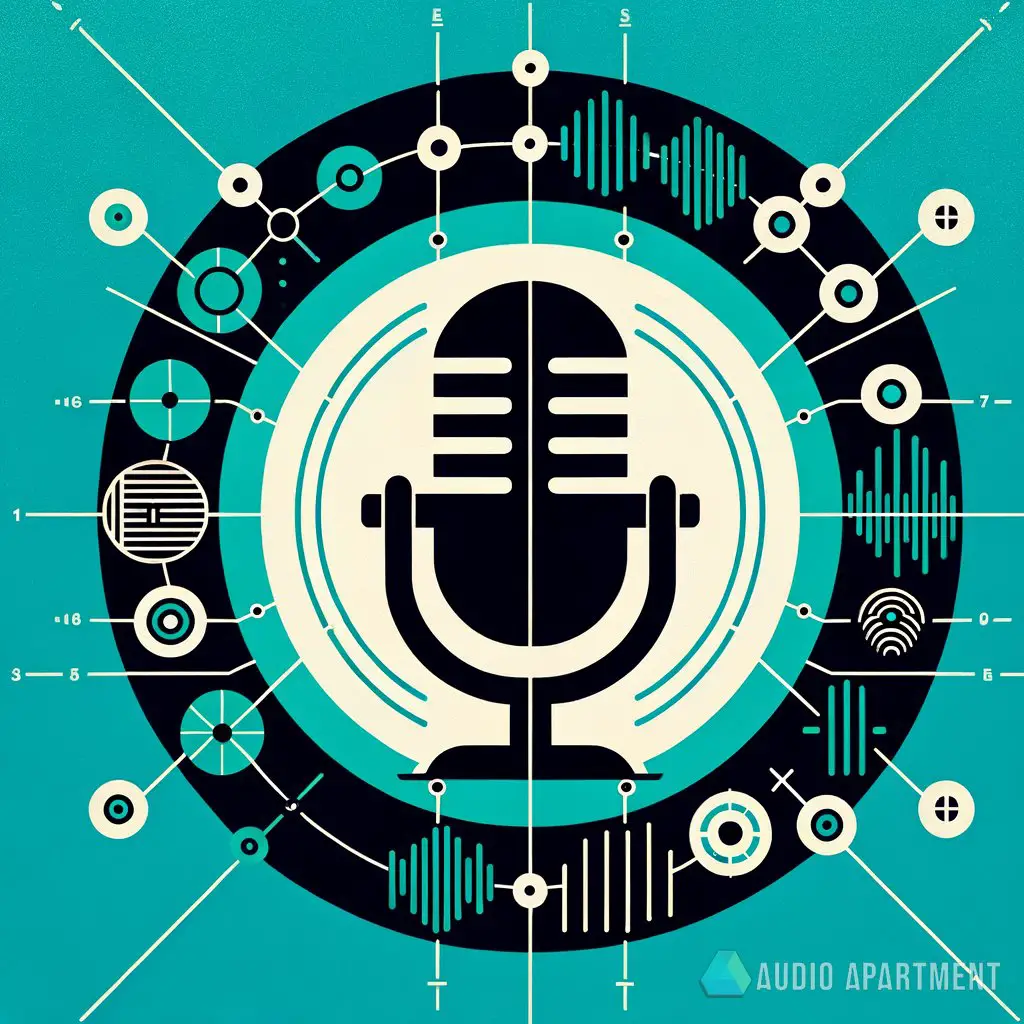Ever been at a party where the music just hits you right, but while dishing on the latest bop, someone brings up mic polar patterns? Why do microphone polar patterns matter so much?
If you’ve got the best gear, like the ones in this list of top-notch studio monitors, shouldn’t that be enough? Trust me, understanding this can change your game.
We’ll cover the essentials to get you up to speed.
Key takeaways
- Microphone polar patterns dictate how a mic picks up sound from various angles.
- Choosing the right pattern is crucial for isolating or embracing environmental sounds.
- Cardioid mics are best for studio recordings, while omnidirectional mics suit live performances.
- Understanding mic technique can greatly enhance your recording quality.
What are microphone polar patterns and why do they matter?
Microphone polar patterns are like the secret sauce to nailing that impeccable sound. They define how microphones pick up sounds from different directions, which is crucial when you’re trying to capture melodies or bars without all that unwanted noise crashing the party.

- Cardioid Patterns: Imagine a heart-shaped pattern where the mic loves sounds from the front and gives the cold shoulder to the back. Perfect for your home studio where you want to keep echoes and your neighbor’s hip-hop rehearsal out of your mix.
- Omnidirectional Patterns: Ever wished you could be a fly on the wall and catch every word in the room? Omnidirectional mics do just that, grabbing audio from all around. They’re the ones you need if you’re aiming for a natural vibe, like recording an unplugged session.
- Figure-8/Bidirectional Patterns: These guys pick up the spat between vocalists facing each other while cancelling out the chaos on the sides. They’re old school, but still clutch when you want that intimate face-off feel in your track.
If you want the lowdown on the kind of gear that’ll help you harness these patterns, check out this rundown of the best studio microphones.
So, here’s my take – I’m no guru, but I’ve learned enough mixin’ tracks in my shoebox, I mean home studio, to know that polar patterns are key. They’re like the bartender’s shaker, mixing the right flavors for a tight drink.
Take my buddy’s cover band – they cut their first demo using just a cardioid mic. The sound?
Tight, with none of that echoey mess from his cramped living room. Now that’s what I call sonic mixing mojo.
“Microphone polar patterns are like the secret sauce to nailing that impeccable sound. They define how microphones pick up sounds from different directions, which is crucial when you’re trying to capture melodies or bars without all that unwanted noise crashing the party.”
Remember that scene in “Walk the Hard Way,” where the singer’s voice echoes through the studio, only to be tamed by a crafty audio engineer wielding a figure-8 mic? That’s polar patterns in action, man.
Hit up this treasure trove of essential audio mixing techniques for home studios to boost your game.
AKAI Professional MPK Mini MK3

AKAI Professional MPK Mini MK3
Impact of polar patterns on recording quality
When diving deeper into the world of microphone polar patterns, one must consider how these patterns influence the recording quality. For instance, a cardioid mic typically has a sensitivity pattern that’s -6dB at 90 degrees, meaning sounds coming from the sides are half as loud as those from the front, which helps isolate the desired sound source effectively.
- Recording Voices: If you’re capturing a solo podcast, a cardioid pattern mic ensures your voice is center stage, mitigating the buzz from your A/C.
- Capturing Instruments: For live sound recording, an omnidirectional mic can make or break the authenticity of the atmosphere represented in the track.
Elevate your mixing and recording knowledge by exploring these tips on crafting the perfect bass tone in your mixes.
Best practices for selecting microphones
Understanding the environment you’re recording in is crucial when selecting a microphone. An overly sensitive omnidirectional mic in a reverberant room can be disastrous, just as much as a cardioid mic might limit capturing the full essence of a choir.

- Studios: A cardioid mic is typically the go-to choice, providing a solid balance between sound isolation and quality.
- Field Recording: Here’s where an omnidirectional pattern can truly shine, giving you a realistic sense of space and presence.
Dive into how room acoustics play a pivotal role in production with this article on why room acoustics are important in music production.
Polar patterns and their frequency response
Not all mics are created equal, even within the same polar pattern category. Frequency response varies, which affects how different sounds are picked up.
For example, some cardioid mics might boost frequencies around 2-5 kHz to enhance speech intelligibility.
- Understanding Specs: Check the frequency response charts when shopping for a mic. They’ll show you peaks and valleys indicating how a mic performs across different frequencies.
For more gear that can influence your sound, take a look at these cutting-edge studio headphones to match your recording needs.
Role of polar patterns in mic technique
Proper mic technique can’t be overstated, and polar patterns are an intrinsic part of that. Singers using a cardioid mic, for instance, must avoid drifting too far off-axis to prevent volume drops and EQ shifts that can muddy the mix.
- Dynamic Control: Squaring up to a cardioid mic vs. working the sides of a figure-8 mic requires different vocal dynamics and positioning, which is crucial for a consistent recording.
Check out some of the best DAWs for producers to pair with your mic technique mastery.

Futuristic tech in polar patterns
Recent advancements are producing mics that have adjustable polar patterns, even after recording. Imagine a session where you can tweak the polar pattern in post-production, similar to changing a filter on a photo.
- Innovation on the Horizon: This tech could open up new avenues in audio engineering, making it one of the more anticipated leaps in microphone design.
Keep up with the latest in modern music production, including this new mic tech, by checking out why modular synthesizers are popular.
Before we continue, let’s take a moment to decode some crucial stats and names that highlight the influence of polar patterns on recording.
Summary of data table: The following table presents key attributes that distinguish different microphone polar patterns, such as their typical decibel sensitivity and common applications, which can inform your decision when pairing microphones with recording settings.
| Polar Pattern | Sensitivity (dB) at 90 Degrees | Common Applications |
|---|---|---|
| Cardioid | -6dB | Podcasts, Studio Recordings, Voice-Overs |
| Omnidirectional | 0dB | Field Recordings, Live Performances |
| Figure-8/Bidirectional | -Infinity (null sensitivity) | Duets, Interviews |
When it comes to maximizing the performance of microphones in any recording scenario, there are some clear dos and don’ts that can make or break the audio quality. Follow these tips to ensure you’re getting the best out of your mics and recording space.
| Do | Don’t |
|---|---|
| Use a cardioid pattern to isolate the sound source. | Ignore room acoustics when choosing a polar pattern. |
| Check the frequency response chart before purchasing. | Assume all mics of the same pattern are identical. |
| Adjust your mic technique based on the polar pattern. | Overlook the off-axis coloration in directional mics. |
| Utilize omnidirectional mics to capture room ambience. | Use figure-8 mics in noisy environments. |
More audio recording tips
Whether you’re a fresh face in the audio production scene or just looking to brush up your skills, a few extra tips can go a long way. Here’s how to make your recordings shine:
- Test different mic placements to find the sweet spot for your sound source.
- Pair the right microphone with your source — not all vocals or instruments shine with the same mic.
- Keep a pop filter handy to reduce plosives, especially when using cardiois close-up.
- Invest in some quality headphones to monitor your recording in real time; it’s a game changer.
- Don’t skimp on your audio interface — it’s the bridge between your mics and your DAW.
- Regularly update your DAW and plugins to take advantage of the latest features and fixes.
- Lastly, always back up your recordings and sessions. Losing data is like dropping your mic — it hurts.
If you are a visual learner, check out this video titled ‘Microphone Polar Patterns Explained | Audio Lab | Captain Pikant | Thomann’
Frequently asked questions (FAQ)
Can I change the polar pattern of a microphone after recording?
Once a recording is made with a specific microphone polar pattern, you can’t change the pickup pattern of the sound that was captured. However, some modern microphones offer multiple patterns that can be selected before you hit record, and innovative technology on the horizon might allow for post-recording adjustments.
Does the distance from the microphone affect the polar pattern?
The polar pattern remains consistent regardless of the distance, but proximity to the microphone can influence the sound due to the proximity effect, which boosts bass frequencies when a sound source is close to a cardioid or figure-8 microphone. It’s crucial to consider both distance and pattern to achieve the desired sound.
Should I use a shock mount with different polar patterns?
Absolutely, a shock mount is recommended for any polar pattern to reduce handling noise, vibrations, and other unwanted rumbles that can be picked up by the sensitive microphone. It doesn’t alter the polar pattern but ensures the cleanest recording possible.
Final thoughts
As we wrap up this deep dive into the sonic sphere of microphone polar patterns, remember that your choice of mic and its pattern can have profound effects on the final sound of your production. It’s not just about capturing sound; it’s about crafting it.
So, explore and experiment with different patterns and techniques to find your unique audio signature.
Have polar patterns impacted your recordings in a way that surprised you? Did I cover everything you wanted to know? Let me know in the comments section belowI read and reply to every comment. If you found this article helpful, share it with a friend, and check out my full blog for more tips and tricks on perfecting your recording setup.
Thanks for reading, and keep creating those killer sounds!















